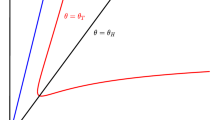Abstract
In this paper, we consider a diffusive predator–prey model with modified Leslie–Gower schemes and additive Allee effect on prey under homogeneous Neumann boundary condition. Firstly, we investigate the qualitative properties of the system including the persistent property, and local and global asymptotical stability of the unique positive constant equilibrium point of the system. Next, we also show the existence and nonexistence of nonconstant positive steady states of the reaction–diffusion system, which reflect the effect of large diffusivity.










Similar content being viewed by others
References
Aguirre P, González-Olivares E, Sáez E (2009a) Two limit cycles in a Leslie–Gower predator–prey model with additive Allee effect. Nonlinear Anal RWA 10:1401–1416
Aguirre P, González-Olivares E, Sáez E (2009b) Three limit cycles in a Leslie–Gower predator–prey model with additive Allee effect. SIAM J Appl Math 69:1244–1269
Allee WC (1931) Animal aggregations, a study in general sociology. University of Chicago Press, Chicago
Bazykin AD (1998) Nonlinear dynamics of interacting populations. World Scientific, Singapore
Boukal DS, Sabelis MW, Berec L (2007) How predator functional responses and Allee effects in prey affect the paradox of enrichment and population collapses. Theor Popul Biol 72:136–147
Chen SS, Shi JP (2012) Stability in a diffusive Holling–Tanner predator–prey model. Appl Math Lett 25:614–618
Chen FD, You MS (2008) Permanence, extinction and periodic solution of the predator–prey system with Beddington–DeAngelis functional response and stage structure for prey. Nonlinear Anal RWA 9:207–221
Conway ED, Smoller JA (1986) Global analysis of a system of predator–prey equations. SIAM J Appl Math 46(4):630–642
Dennis B (1989) Allee effect: Population growth, critical density, and the chance of extinction. Nat Resour Model 3:481–538
Freedman HI, Wolkowicz GSK (1986) Predator–prey systems with group defence: the paradox of enrichment revisited. Bull Math Biol 8:493–508
Gascoigne JC, Lipcius RN (2004) Allee effects driven by predation. J Appl Ecol 41:801–810
Gilbarg D, Trudinger NS (2001) Elliptic partial differential equations of second order. Springer, Berlin
Henry D (1993) Geometric theory of semilinear parabolic equations. Lecture notes in mathematics, vol 840. Springer, Berlin
Hsu SB, Huang TW (1995) Global stability for a class of predator–prey systems. SIAM J Appl Math 55:763–783
Huang CY, Li YJ, Huo HF (2012) The dynamics of a stage-structured predator–prey system with impulsive effect and Holling mass defence. Appl Math Model 36:87–96
Kent A, Doncaster CP, Sluckin T (2003) Consequences for predators of rescue and Allee effects on prey. Ecol Model 162:233–245
Kramer AM, Dennis B, Liebhold AM, Drake JM (2009) The evidence for Allee effects. Popul Ecol 51:341–354
Lin LS, Ni WM, Takagi I (1988) Large amplitude stationary solutions to a chemotaxis systems. J Differ Equ 72:1–27
Liu J (2013) Qualitative analysis of a Holling–Tanner predator–prey model with mutual interference. Appl Math Comput 219:5283–5289
Lou Y, Ni WM (1996) Diffusion, self-diffusion and cross-diffusion. J Differ Equ 131:79–131
Morozov A, Petrovskii S, Li BL (2004) Bifurcations and chaos in a predator–prey system with the Allee effect. Proc R Soc Lond B 271:1407–1414
Nirenberg L (2001) Topics in nonlinear functional analysis. American Mathematical Society, Providence
Pang PYH, Wang M (2003) Qualitative analysis of a ratio-dependent predator–prey system with diffusion. Proc R Soc Edinb 133A:919–942
Peng R, Wang MX (2007) Global stability of the equilibrium of a diffusive Holling–Tanner prey–predator model. Appl Math Lett 20:664–670
Shao YF, Dai BX (2010) The dynamics of an impulsive delay predator–prey model with stage structure and Beddington-type functional response. Nonlinear Anal RWA 11:3567–3576
Shi HB, Li WT, Lin G (2010) Positive steady states of a diffusive predator–prey system with modified Holling–Tanner functional response. Nonlinear Anal RWA 11:3711–3721
Smoller J (1983) Shock waves and reaction–diffusion equations. Springer, New York
Stephens PA, Sutherland WJ (1999) Consequences of the Allee effect for behaviour, ecology and conservation. Trends Ecol 14:401–405
Tanner JT (1975) The stability and the intrinsic growth rates of prey and predator populations. Ecology 56:855–867
Wollkind DJ, Collings JB, Logan JA (1988) Metastability in a temperature-dependent model system for predator–prey mite outbreak interactions on fruit flies. Bull Math Biol 50:379–409
Yang WS (2013) Global asymptotical stability and persistent property for a diffusive predator–prey system with modified Leslie–Gower functional response. Nonlinear Anal RWA 14:1323–1330
Ye Q, Li Z (1990) Introduction to reaction–diffusion equations. Science Press, Beijing
Acknowledgments
The authors would like to thank the editor and the anonymous referees for their valuable comments and suggestions on this paper. This work was supported by the Program for New Century Excellent Talents in University (NCET-10-0097), the NSFC Tianyuan Foundation (Grant No. 11226256) and the Zhejiang Provincial Natural Science Foundation of China (Grant No. LY13A010010).
Author information
Authors and Affiliations
Corresponding author
Additional information
Communicated by Antonio José Silva Neto.
Rights and permissions
About this article
Cite this article
Yang, L., Zhong, S. Dynamics of a diffusive predator–prey model with modified Leslie–Gower schemes and additive Allee effect. Comp. Appl. Math. 34, 671–690 (2015). https://doi.org/10.1007/s40314-014-0131-1
Received:
Revised:
Accepted:
Published:
Issue Date:
DOI: https://doi.org/10.1007/s40314-014-0131-1




